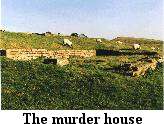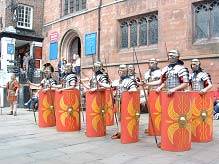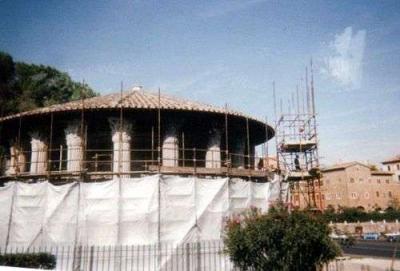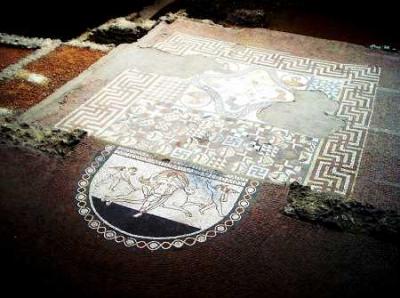

 |
As mentioned in an earlier article on Housesteads Fort, Hadrian`s Wall, outside the larger forts civilan settlements sprang up. Here, although originally soldiers were not allowed to marry, their wives and childen lived. Under the foundations of a shop, or tavern, in the vicus at Housesteads in 1933, archaeologists discovered the skeletons of a middle-aged man and that of a woman. Embedded in the man`s ribs was a broken sword. Who knows what happened all those years ago that caused the murders? Who buried them? He seems to have got away with it. |
There are many Roman re-enactment groups in Britain.
THE DEVA VICTRIX Leg XX
 |
These enthusiasts provide Chester with its own display team.
In Springtime they celebrate the standards of the legion leaving the Temple of Mars. In Summer they present a visual and verbal portrayal of life at Chester nearly 2,000 years ago to the tourists. At Christmas they take part in the torchlight parade as part of their Saturnalia celebrations. Although they are, as they say, "dedicated to pushing the boundaries of their knowledge of the Roman period" they also seem to have a lot of fun as their motto is : ~~ ULTIMUM INTRA PUGNA PRIMUM INTRA TABERNA ~~ (Last into battle first into the pub) |
Maryemm
FAMILY LIFE
Life in Roman times for women was quite hard. The father was the most important member of the family. He had the power of life or death over everyone. When a new baby was born it would be laid at its father's feet. If the father picked the baby up it would live, and if he ignored the baby it would be taken away to die. Mothers and children were never seen as important.
From the 1st century B.C. women began to have more rights and could divorce unkind husbands. But they were never seen as really being equal to men.Helen

The temple is in the Forum Boarium, the ancient cattle market of Rome.
From the 2003 National Latin II Test: Multīs post annis, Romanī Forum Boarium condidērunt ubi Herculēs et Cacus pugnāverant.
Sandyrose
AMAZONS IN BRITAIN? In the 1960s the remains of what proved later to be two women were discovered at Brougham in Cumbria.
It was not till the 2000 that modern technologies revealed that the remains were the cremated bodies of two women warriors thought to have come from the Danube region of Eastern Europe,
The cemetery at Brougham served a fort and the civilian settlement of Brocavum in the 3rd century .Thanks to these modern technologies archaeologists have been able to determine the ages and gender of the dead and to build up a detailed picture of Roman funerals in Brougham.
The two women are believed to have died some time between AD220 and 300 and to have been cremated along with their horses and weapons.
Hilary Cool, the director of Barbican Research Associates, which specialises in post- excavation archaeological analysis, said in "British Archaeology" "Though the numerii are generally referred to as irregular units, they are not thought of as having women among their ranks. However, the unit came from the area where the Ancient Greeks placed the origin of women warriors called Amazons. Could the numerii be even more irregular than anyone has ever dreamt?"
Both women aged between 20 and 45 seem to have been held in high regard as the possessions burnt alongside them prove.
Maryemm
"See that the housekeeper perform all her duties. If the master has given her to you as wife, keep yourself only to her. Make her stand in awe of you. Restrain her from extravagance. She must visit the neighbouring and other women very seldom, and not have them either in the house or in her part of it. She must not go out to meals or be a gadabout¬Öshe must be neat herself and keep the farmstead neat and clean. She must clean and tidy the hearth every night before she goes to bed." ~ CATO
ISSUE 1 : COVER ILLUSTRATION
The "House of Paquius" completely uncovered in 1927. is generally attributed to the baker(pistor) Paquius Procuis, who became a mayor of Pompeii. According to widespread electoral propaganda, he was the most influential citizen in this quarter of the city. To the right is an image of Paquius and his wife.
The floor is a carpet of mosaic and the entrance section portrays a dog tied to a leaf of the door, while the floor mosaics in the atrium are divided into panels portraying different animals. The courtly rooms and lodgings open on to the garden in the back and the skeletons of seven young boys killed by the eruption were found in the exedra.
Fran
ROMAN FIND IN SUFFOLK OCTOBER 2005
An inquest just held in Bury St Edmunds, has determined that the hoard of Roman coins unearthed by a metal detector enthusiast, Paul Flack, last October, is the largest discovery of its kind in Britain.
The 621 copper alloy coins, from the period of usurper Emperors Carausius (287 - 293 AD) and Allectus (293 - 296 AD) and minted at London and possibly Southampton or Colchester,could have been buried during times of political turmoil.
Mildenhall Museum may now buy the coins.
Maryemm
ROMAN AQUEDUCTS There were many aqueducts that served Rome as well as ones that provided other Roman cities with water. The Aqua Appia was the first aqueduct to serve Rome. Aqua Anio Vetus, Aqua Marcia, Aqua Claudia and Aqua Anio Novus were other aqueducts that flowed to Rome. They were supplied by the Anio River. The Aqua Appia was 10.5 miles long. Forty years after the completion of the Appia, the Anio Vetus was being built. It length was 40 miles long. Other aqueducts to Rome included the Aqua Tepula, Aqua Julia, Aqua Virgo, Aqua Alsietina, Aqua Hadriana, and the Aqua Augusta. Ancient Rome and the surrounding countryside must have been quite a site. The beauty and mystery of these incredible structures can still be experienced today.Norm
LULLINGSTONE ROMAN VILLA (KENT)

Built around 300 AD, the villa was extended over the following 300 years and much of it is still visible today. The villa has many features including superb mosaic floors, wall paintings, a fourth century bath complex and even skeletal remains.
The photograph of this mosaic was taken while on a tour of Roman Britain in July 2003 by:
Ralph Balzac
THE ACROPOLIS
In our Greek 102 class we have been translating a story about a Greek farmer and his family who visit Athens for a festival and are awe-struck by the splendor of the Parthenon. It must have been a truly spectacular sight when it was completed about 433 BC with the carvings and the golden statue of Athena, their patron goddess.
I was reminded of our visit to Athens last year and how beautiful and awesome the building still is today even though it has been ravaged by time, conquerors, and the elements. Although many of the original statues and carvings have been destroyed or sacked, the wealth of ideas and the innovative thinking of the Greek scholars that it represents still amaze us and enrich our civilization in the academic disciplines that have sprung from them. Those have been indestructible.
Standing on the deck of our cruise ship in Piraeus, we glimpsed the marble Acropolis gleaming majestically and proudly above the sprawling city in the late afternoon sun and offered a silent salute as we weighed anchor and reluctantly left it behind us.
Johann
ANCIENT COFFIN DISCOVERED IN CYPRUS
As reported by George Psyllides of the Associated Press, a sarcophagus was discovered in Nicosia, Cyprus in March of 2006. Like so many other ancient tombs and archeological sites, the site of this ancient coffin, decorated with color illustrations from Homer's epics had been looted.
It was found by construction workers near the nearby village of Kouklia in the coastal area of Paphos.
Pavlos Flourentzos, Director of Cyprus' Antiquities Department described the decoration of the sarcophagus as unique in color and subject, the colors being vivid reds and blues, and black on a white background, and stated that is was less faded than two similar sarcophagi, the only other two ever discovered in Cyprus before this discovery.
The scenes are believed to be depictions of Ulysses from Homer's Iliad and Odyssey and "archeologists think the scenes hint at the status of the coffin's occupant." says Mr. Psyllides.
One of the paintings is said to be showing Ulysses and his comrades' escape from the blind Cyclops Polyphemos' cave. Another depicts a battle beween Greeks and Trojans from the Iliad.
Allie Mae
THE BECHAREL FESTIVAL
In March 2005 Becharel, the "city of the books and bookstores," in Brittany, held its First European Festival of Latin and Greek. Guest celebrities included the writer and expert Jacques Lacarriere, the Greek singer Angela, the writer Hubert Monteilhet ("Neropolis"), Anne de Leseleuc, author of thrillers and detective novels. Jacqueline de Romilly (Academie Francaise) and the TV Journalist Patrick Poivre d'Arvor. The Graf von Rothenburg, translator of 22 Asterix titles into Latin, was present also.
A special dinner was eaten the "Apicius way" with a "defile de mode antique" followed by a Greek Ball with musicians.
The Festival was such a success that it was held again this March, and those of you who understand French will be interested to see the complete programme of events, listing the various invited artistes, at: FESTIVAL
Maryemm
LATIN QUOTES
Amor vincit omnia. - Love conquers all. Dominus illuminatio Mea - The Lord is my light. motto of Oxford University. Fiat lux. - Let there be light. Audi, vide, tace, si tu vis vivere - Hear, see, be silent, if you wish to live (in peace.) Carpe diem - Seize the day! Cogito ergo sum - I think, therefore I am Divide et impera - Divide and conquer. (attributed to Julius Caesar.) Festina lente! - Make haste slowly (proceed quickly, but with caution - a motto of Augustus Caesar) Mater artium necessitas - Necessity is the mother of invention. (Apuleius) Repetitio est mater studiorum. - Repetition is the mother of study.
Joan
Page 24 ~ Vāle!
ECCE II Contents